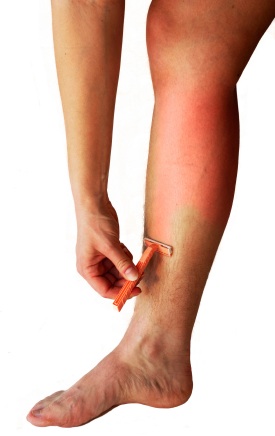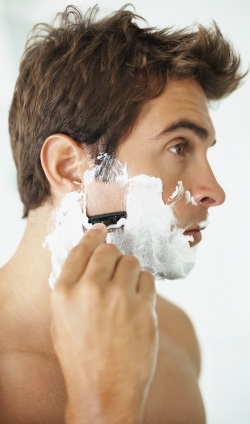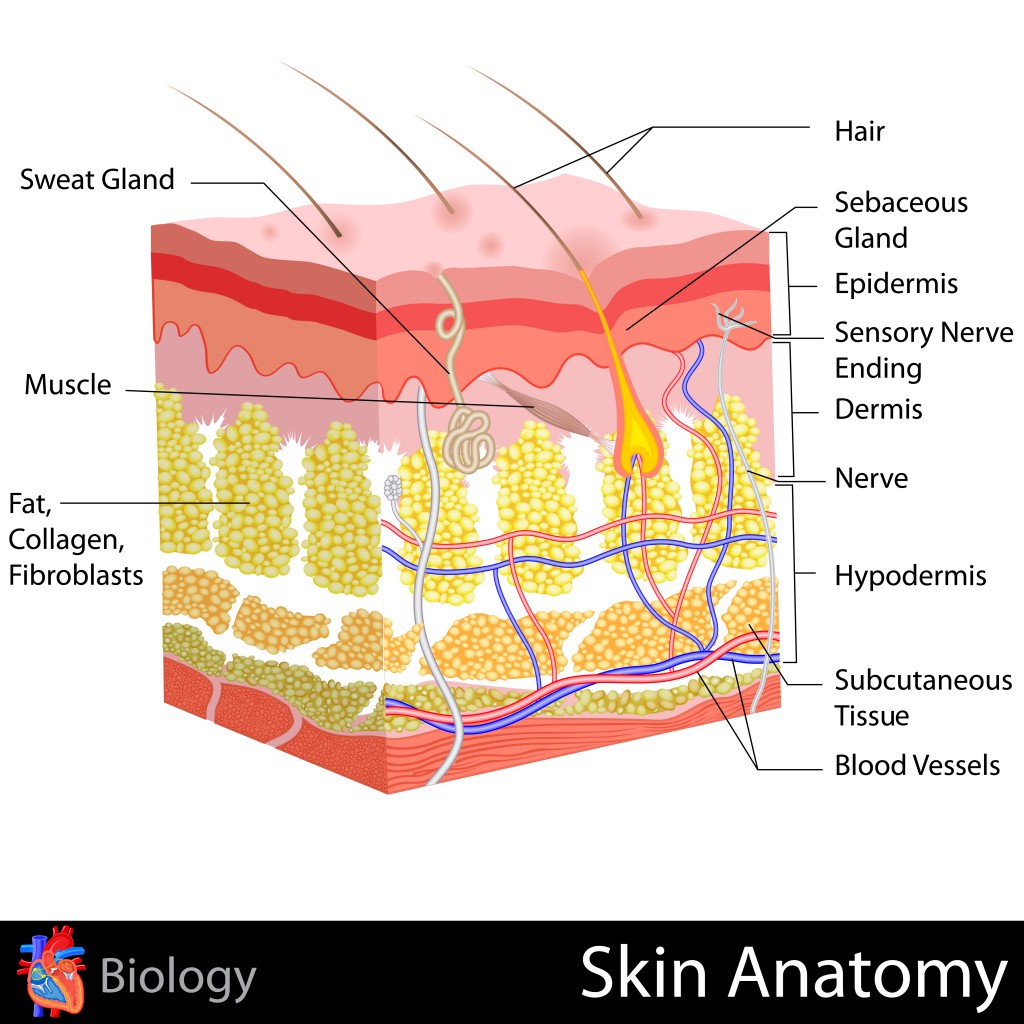Do you get chafed, red skin after shaving? Razor burn is a common effect of shaving, causing uncomfortable stinging, itching, burning and raised red bumps. Almost everyone who shaves with a razor may experience razor burn occasionally, and possibly nicks and cuts too. Razor burn can occur in men or women anywhere the skin is shaved: face, legs, underarms, bikini line and pubic area. The good thing about razor burn is that it is usually preventable and it is definitely treatable. There are better ways to deal with the effects of razor rash than dabbing bleeding spots with tissue or scratching itching, irritated bumps. Thankfully there are easy ways to avoid it and soothing remedies to quickly cure it when it happens to you.
Alternative Names
Razor burn is also called razor rash, shaving rash, barber’s itch, barber’s rash, shaving burn, shaving bumps or razor bumps. The medical term for inflammation of the skin and hair follicles, cuts, abrasions, irritation and ingrown hair caused by shaving is pseudofolliculitis barbae. There are different types of folliculitis, some caused by staphylococcal bacteria, some caused by different fungus infections. Persistent razor burn that is very itchy and irritating may be suspected of accompanying bacterial or fungal infection that needs medical treatment if it doesn’t clear up with herbal or home remedies, but occasional razor burn is probably due to shaving technique.
Symptoms
Razor burn symptoms include red, rash-like appearance of skin after shaving, raised red bumps accompanied by skin itching, pain and irritation and infected follicles. The rash may resolve in a few days by itself in mild cases or in more serious cases may develop into ingrown hair when hair starts to grow back, even forming infected bumps. Nicks and cuts can also occur with razor burn. Razor burn and especially infected bumps can be very uncomfortable and unsightly.
Causes
There are various causes of razor burn. The kind of equipment used to shave makes a big difference in skin condition afterward. Shaving habits and techniques, preparation of skin and hair before shaving, methods of after-care, presence of bacterial or fungal infection, and shaving hair too close causing ingrown hair all have a big impact on skin condition after shaving.
Razor Burn? Get Remedies Fast!
Using a razor with a dull blade and having to shave the area multiple times to remove all the hair can irritate the skin and cause razor burn. Use a fresh, sharp shaver with a lot of warm water and moisturizing cream or an electric shaver to get a clean shave after passing over the skin just once without applying too much pressure.

Shaving habits either protect or damage the skin during shaving. Shave in the direction the hair is growing instead of the opposite direction to avoid pushing the hair into the follicle. Use short strokes without pulling the skin taught to avoid scraping the top layer of the skin and causing a rash. Take care while shaving not to rush and cut yourself or press too hard on or cut skin.
Preparing the skin before shaving will result in a better shave and will protect the skin. Gently wash the area to be shaved with a mild soap and warm water and apply an emollient shaving cream before using a razor. If you don’t want to wash the skin, soak a thick, clean wash cloth in hot water and some moisturizing oil and use it as a compress on the skin before shaving to avoid skin damage. Alternately, soak in a warm tub with a moisturizing bath additive before shaving.
Taking care of the skin after shaving can prevent razor burn as well. Use a gentle moisturizer without perfumes or chemicals to sooth shaved skin. If skin has cuts or nicks, clean them with an astringent or antibacterial ointment to prevent infection and scabbing.
Skin that is infected is more susceptible to razor burn and should be treated with extra caution if shaving is necessary. Try to clear up bacterial and fungal skin infections before shaving if possible. Otherwise, wash gently and apply a thin layer of antiseptic or antibacterial cream before gently shaving with a fresh, clean razor.
Shaving too close, especially curly hair, may cause ingrown hair. The hair follicle snaps back into the skin after shaving if cut too short, and curly hair may grow under the skin after shaving. Avoid shaving too close or shaving the same area more than once.
Risk Factors
Razor burn can be prevented by using care before, during and after shaving, although there are certain risk factors that make razor burn more probable. Risk factors for razor burn include extremely sensitive skin, thick, curly hair, skin conditions like eczema, infected skin, or sunburn, very dry skin and dry shaving.
Extremely sensitive skin will chafe more easily than normal skin. Extra caution for shaving will avoid injury and irritation. Always pay attention to moisture during the shaving process with sensitive skin and use creams and gels with natural ingredients instead of fragrances and chemicals.
Thick, curly hair has more of a tendency to become ingrown than straight or fine hair. When shaving curly hair, use extra warm water and extra creamy moisturizing shave gel and lotions to soften hair and protect skin. Waxing or depilatory treatments may be a better way to remove really thick hair to avoid razor burn and ingrown hair.
Skin conditions like eczema and very dry skin can be aggravated by shaving. Prescription creams or lotions for skin conditions should be used before shaving skin with any medical or disease conditions.
Dry shaving should be avoided at all costs to prevent risk of razor burn, nicks and cuts and taking off the outermost layer of skin. Water and moisturizer is very important during the shaving process and shouldn’t be skipped.
Prevention Tips
Use a fresh blade to shave, not a dull or old blade, and definitely use a clean and preferably sterilized blade. Old razors may accumulate soap scum and tiny hairs from previous use, harbor bacteria and fungus or have rust. You do not want any of that near your skin and especially not in any nicks or cuts.

Do not rush through your shaving routine or neglect to use warm water and moisturizing creams and gels. Doing so increases your risk of nicks and cuts, as well as drying out and irritating the skin. Take your time and take care of your skin while shaving.
Use an electric shaver if a shaver with blades always gives you razor burn. Electric shavers are gentler on the skin and have blades covered with mesh foils for safer shaving.
Keep the skin moist before, during and after shaving. Using moisture is one of the best ways to ensure a smooth, injury-free shave and avoid razor burn. Soak the skin with warm water or hold a warm, wet towel on it for a few minutes, use a gentle moisturizing cream or gel during shaving and apply a creamy moisturizer to freshly shaved skin.
Shave in the direction of hair growth, not against it. Shaving this way avoids pushing the hair shaft into the follicle, causing bumps that can get infected or ingrown hair.
Don’t shave too closely or push the razor into the skin, especially around cheekbones, ankles and knees. Don’t pull skin tightly when shaving, especially with a brand new, sharp razor.
Only shave the area once, not twice. A dull blade may not cut all the hair in an area on one swipe, requiring you to shave over more than once to get all the hair, but this risks scraping off the top layer of skin cells and irritating or damaging skin.
Other Causes
- Gently cleanse skin with mild, moisturizing soap and warm water before shaving. This removes any dirt, dead skin cells and built-up body oils and plumps up the top layer of skin.
- Soak skin in warm water or treat it to warm wet towels or compresses before shaving. This puts moisture into the skin and softens it, protecting it from scraping and cuts.
- Apply a soothing moisturizer with aloe vera after shaving to cleanse and refresh shaved skin.
- Don’t use cologne or perfume on freshly shaved skin, or products with a lot of chemicals. Use gentle natural ingredients to soothe and protect sensitive exposed skin after shaving.
- Never shave dry skin. Always use moisture throughout the entire shaving process for maximum skin protection.
- Stop shaving for a while to completely avoid razor burn, especially if skin is sensitive, infected or injured in any way.
- Use a depilatory cream or waxing instead of shaving if razor burn is a particular problem for your skin.
Test and Diagnosis Considerations
Causes of recurring infected razor burn are diagnosed by a physical exam. A doctor will examine the skin closely, and if red bumps are filled with pus or fluid, samples from skin scrapings will be tested for bacteria and fungus. Blood tests for diabetes and other chronic disease conditions are done for recurring or unusual folliculitis. Some severe forms of the condition are treated with prescription medications.
Treatment Options – Herbal
Many herbal treatments can soothe and heal razor burn. Aloe vera from a freshly cut aloe vera spear will soothe and clear razor burn. Fresh calendula cream provides antiseptic protection and soothes redness. A thin layer of eucalyptus salve refreshes and protects scraped skin. Rinsing razor burned skin with cool green tea helps it stop burning and heal. Cold compresses of wet comfrey leaves or wet spearmint leaves are cooling and healing.
Treatment Options – Home Remedies
There are simple home remedies for razor burn. Dissolve two plain aspirins in warm water to make a paste to rub on razor burned skin. Blend a couple of fresh strawberries with a teaspoon of sour cream to apply to razor burn. If legs are razor burned, soak in an oatmeal bath, a bath with a cup of witch hazel, a bath with crushed fresh spearmint leaves, or a bath with a couple of tablespoons of white vinegar to soothe skin irritation and refresh red, scraped skin. Fresh avocado paste smoothed on razor burn is cooling and moisturizing.
Treatment Options – Pharmaceutical
For mild razor burn, benzoyl peroxide is a treatment available over the counter. Usually used for acne, benzoyl peroxide creams and lotions will soothe razor burn as well. More serious razor burn may be treated with cortisone cream or topical steroid cream prescribed by a doctor. For folliculitis from Pseudomonas bacteria, an antibacterial wash or antibiotics ciprofloxacin or levoflaxacin may be prescribed. Fungal folliculitis is treated with antifungal creams like lotrimin and/or pills like fluconazole. A doctor has to prescribe most of these treatments after an examination and diagnosis.


6 Comments
I dry shaved my legs on tuesday ,and the cause has only shown now. Its itchy red bumps and it stings and burns and it looks like little red blisters all over my legs. I never shave dry, but i was in a hurry to go somewhere and now they itching like craze ,and I’ve tried germolene and nivea cream bt it only helps to ease the itching do you know how you can perhaps help me??
Shaved my beards for the first time with a razor and it was all neat,two days after I felt itching all over my neck and everywhere else I shaved.the next day..I had bumps all over.used creams one after the other but it never seems to reduce,instead dey get bigger
try some lemon juice yakub that is after shavin thn apply for some few days like three n u wl see the outcome..wen they appear also do tbe sem rinse woth lemon juice n leave it to dry..it b
helps
I shaved yesterday morning and didn’t start getting bumps until this morning. I was wondering if this was normal also will these help? I’m very skeptical but desperate for a cure
An ounce of prevention is worth a pound of cure. If a cartridge razor gives an irritating shave, try a safety razor and double edge blade instead, along with a brush, quality shaving soap or cream, and an aftershave balm. For me, it worked wonders, and is a lot better than a multi-blade cartridges and canned gel or foam.
No more razor burn, no more irritation, almost never a nick or cut, never any razor bumps, just fantastic, comfortable and very affordable shaves. There is a bit of a learning curve, but just a bit, and it is so worth it! Remember to use a very light touch when using a safety razor. If anyone is interested, Mantic59’s videos on YouTube are an excellent resource, as is Leisureguy’s Guide to Gourmet Shaving book, and The Shave Den forum.
I shaved my vag a few weeks ago and now I see them it burns and I put a warm rag to it it also burn when I pee I scratched it a few times but I made it worse